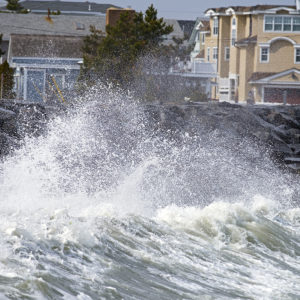If experts are to be believed, climate change is set to reshape America’s physical geography through rising sea levels and increasingly wild weather. Despite the risks, many federal programs are being used to protect some of America’s wealthiest seaside communities. Rather than forcing taxpayers to bankroll their beach lifestyle, the Federal Emergency Management Agency should reform its programs so that the cost of coastal living matches the risk of modern disasters.
Tasked with overseeing the nation’s disaster mitigation and response programs, FEMA runs a “managed retreat” initiative that gives local officials grants to buy and demolish properties at risk of flooding. But recent research by a team of academics from the University of Miami, Harvard University and Stanford University finds that wealthy counties are most likely to receive the money. The researchers also note that poorer areas are more likely to be demolished, which would increase the property value of the wealthy residents who stay.
The use and abuse of federal emergency funding to benefit wealthy coastal and riverine communities has become a routine occurrence. For example, FEMA also manages the National Flood Insurance Program (NFIP). As the largest flood insurance program in the country, the NFIP covers more than 5 million residential policies. But the program relies upon outdated flood-risk maps, meaning that FEMA can’t accurately price the risk of a given area.
While FEMA says that it uses “the best available technical data to create the flood hazard maps,” the NFIP is currently underwater to the tune of $20 billion worth of debt — and that is after Congress forgave an addition $16 billion in 2018. Clearly, no private insurance firm would be able to fail for so many years to the degree with which the NFIP has. But private insurance is often not even an option for consumers, because the NFIP undercuts its private competitors by offering premiums that do not reflect the actual risk.
With taxpayer money shoring up coastal and flood-prone real estate, it’s little surprise that so many Americans are happy to stare down catastrophic climate change. A study by academics at the University of Notre Dame earlier this year found that coastal homeowners who believe in climate change are no more likely to take disaster precautions than their skeptical neighbors.
But why would they?
This multi-billion-dollar moral hazard syndicate is fiercely guarded by political representatives who believe the public purse is bottomless. No doubt under pressure from their homeowning constituents, members of Congress have vowed to fight initiatives that would align NFIP premiums with the risk they cover.
Similarly, a recent bipartisan bill (H.R.3167) calls on FEMA to update its maps. Yet, the same legislation simply reauthorizes the NFIP for an additional five years and allows the program to run up even more taxpayer-funded debt that the bill’s sponsor openly admits could never be paid back. Without a requirement to price risk competitively, these reforms are toothless.
Market-based reform, however, is not impossible. In June, FEMA took a major step by publishing decades of data on flood damage claims. While this increased transparency will allow private insurance companies to better tailor their policies, it doesn’t go far enough. Bureaucrats are still sitting on a trove of data that would support the private insurance market, which would give consumers greater choice while easing the reliance on the NFIP.
These taxpayer-funded federal programs provide welfare for communities that want a certain lifestyle — but don’t want to pick up the bill when things go wrong. With climate change upon us and tides rising, it’s high time for Congress to increase transparency and stop bankrolling an unsustainable subsidy that benefits the rich.
Better mapping and pricing at risk is paramount, and spreading that risk to private insurers is necessary to cut this wasteful federal spending. It’s time for Congress to stop kicking the can down the road and fix the problem.

